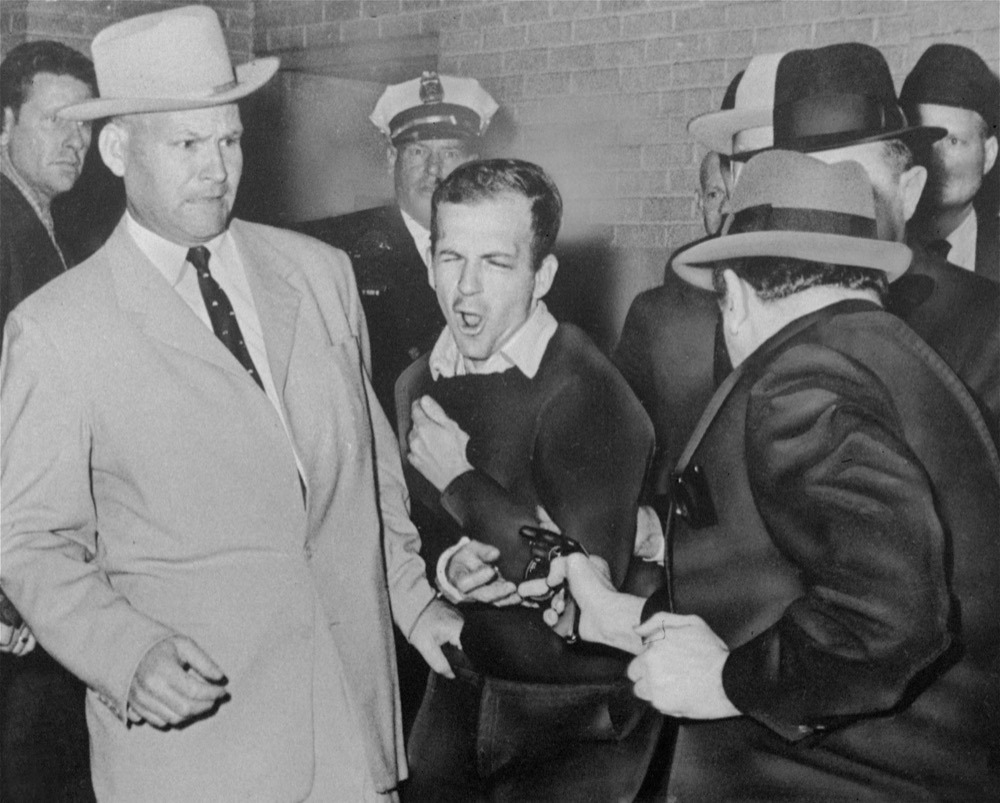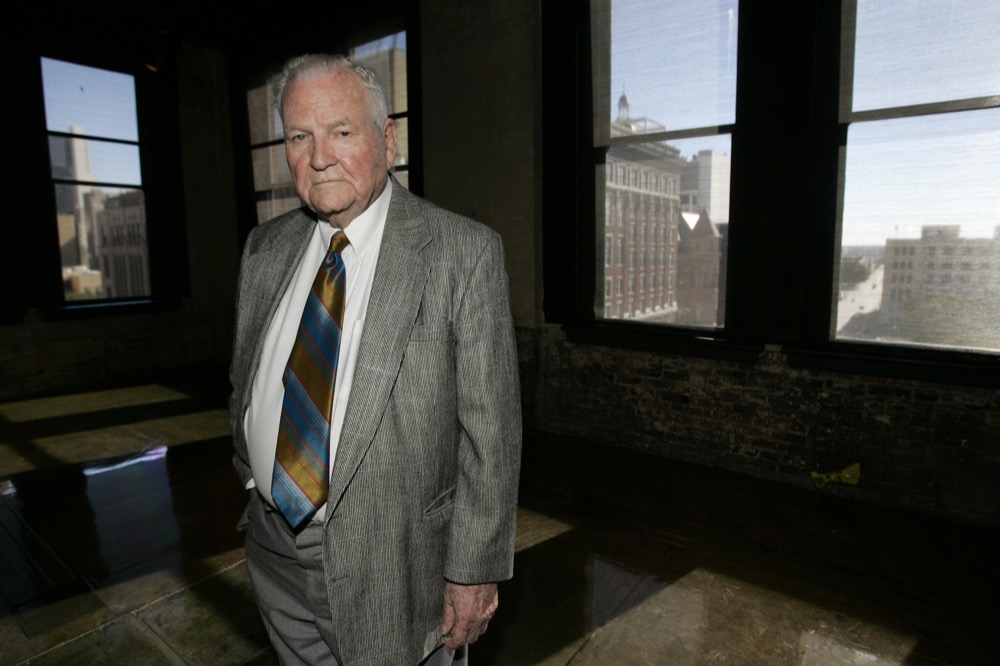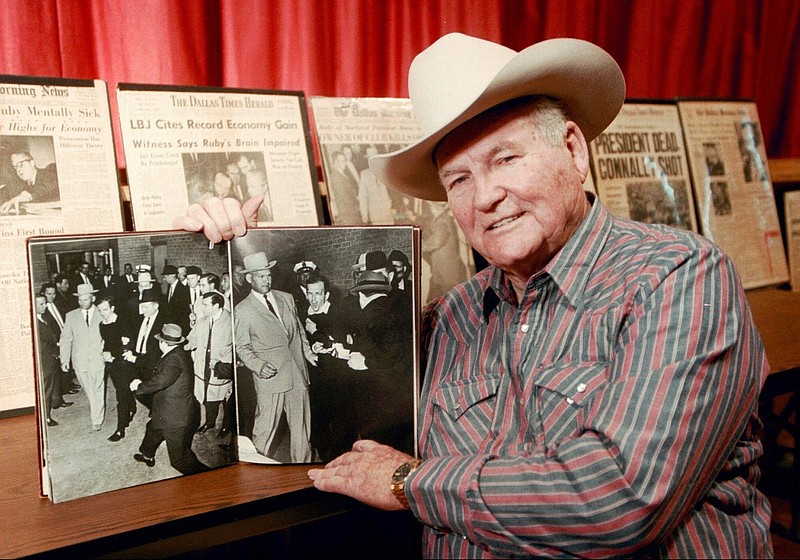 FILE - In this Nov. 24, 1963 file photo, Lee Harvey Oswald reacts as Dallas night club owner Jack Ruby, foreground, shoots at him from point blank range in a corridor of Dallas police headquarters At left is Detective Jim Leavelle. The longtime Dallas lawman who was captured in one of history's most iconic photographs as he escorted President John F. Kennedy's assassin moments before he was fatally shot, has died on Thursday, Aug. 29, 2019. He was 99. (Bob Jackson/Dallas Times-Herald via AP)
FILE - In this Nov. 24, 1963 file photo, Lee Harvey Oswald reacts as Dallas night club owner Jack Ruby, foreground, shoots at him from point blank range in a corridor of Dallas police headquarters At left is Detective Jim Leavelle. The longtime Dallas lawman who was captured in one of history's most iconic photographs as he escorted President John F. Kennedy's assassin moments before he was fatally shot, has died on Thursday, Aug. 29, 2019. He was 99. (Bob Jackson/Dallas Times-Herald via AP)
DALLAS (AP) - Jim Leavelle, the longtime Dallas lawman who was captured in one of history's most iconic photographs as he escorted President John F. Kennedy's assassin as he was fatally shot, has died. He was 99.
Leavelle, distinctive in his light-colored suit and white Stetson, is seen in the photograph with his hand on Lee Harvey Oswald, Leavelle's body stiffening as nightclub owner Jack Ruby shot the handcuffed presidential assassin at close range on live TV in 1963. Leavelle appears shocked as Oswald grimaces in pain.
Leavelle's daughter Tanya Evers told The Associated Press her father died Thursday while visiting her sister in Colorado. He fell earlier this week and broke his hip, requiring surgery at a Denver hospital, Evers said Friday. He responded well to the surgery, she said, but then later suffered a heart attack.
 FILE - In this Nov. 19, 2008 file photo, retired Dallas Police Department Detective Jim Leavelle poses in the former book depository building, now known as The Sixth Floor Museum at Dealey Plaza, from which Lee Harvey Oswald fired the fatal shots killing President John F. Kennedy, in Dallas. Leavelle, the longtime Dallas lawman who was captured in one of history's most iconic photographs as he escorted President John F. Kennedy's assassin moments before he was fatally shot, has died on Thursday, Aug. 29, 2019. He was 99. (AP Photo/Tony Gutierrez)
FILE - In this Nov. 19, 2008 file photo, retired Dallas Police Department Detective Jim Leavelle poses in the former book depository building, now known as The Sixth Floor Museum at Dealey Plaza, from which Lee Harvey Oswald fired the fatal shots killing President John F. Kennedy, in Dallas. Leavelle, the longtime Dallas lawman who was captured in one of history's most iconic photographs as he escorted President John F. Kennedy's assassin moments before he was fatally shot, has died on Thursday, Aug. 29, 2019. He was 99. (AP Photo/Tony Gutierrez)
In the decades after the assassination, Leavelle regularly spoke at schools and before various groups because he believed "he had a responsibility to share his story," said Evers, who lives in San Antonio.
Her father through the decades received mail nearly every day from people asking questions about the assassination or invoking any one of several conspiracy theories, she said.
"He really felt a need to address the theories," Evers said. "He wanted to make sure that people knew there was no conspiracy and that one misguided person could take a shot at a president and succeed."
Leavelle joined the Dallas police force in 1950 and retired from active service in 1975. He was among the lead detectives assigned to investigate Kennedy's Nov. 22, 1963, assassination.
In 2013, Dallas police commanders honored Leavelle with the Police Commendation Award and announced the department's Detective of the Year Award would be named for him. In accepting the honor, Leavelle said he was thinking of other deserving officers, including J.D. Tippit, who was shot and killed by Oswald when Tippit stopped Oswald to question him some 45 minutes after Kennedy's assassination.
In comments after that presentation, Leavelle said that when he saw an armed Ruby approach in the basement of Dallas police headquarters, he tried unsuccessfully to jerk Oswald behind him to shield him from harm.
"Him being real close all I did was turn his body so instead of the bullet hitting him dead center it hit about 3 or 4 inches to the left of the navel," Leavelle said.
The photo that captured the attack was taken by Robert H. Jackson, a photographer for the Dallas Times Herald who won a Pulitzer Prize for his image.
